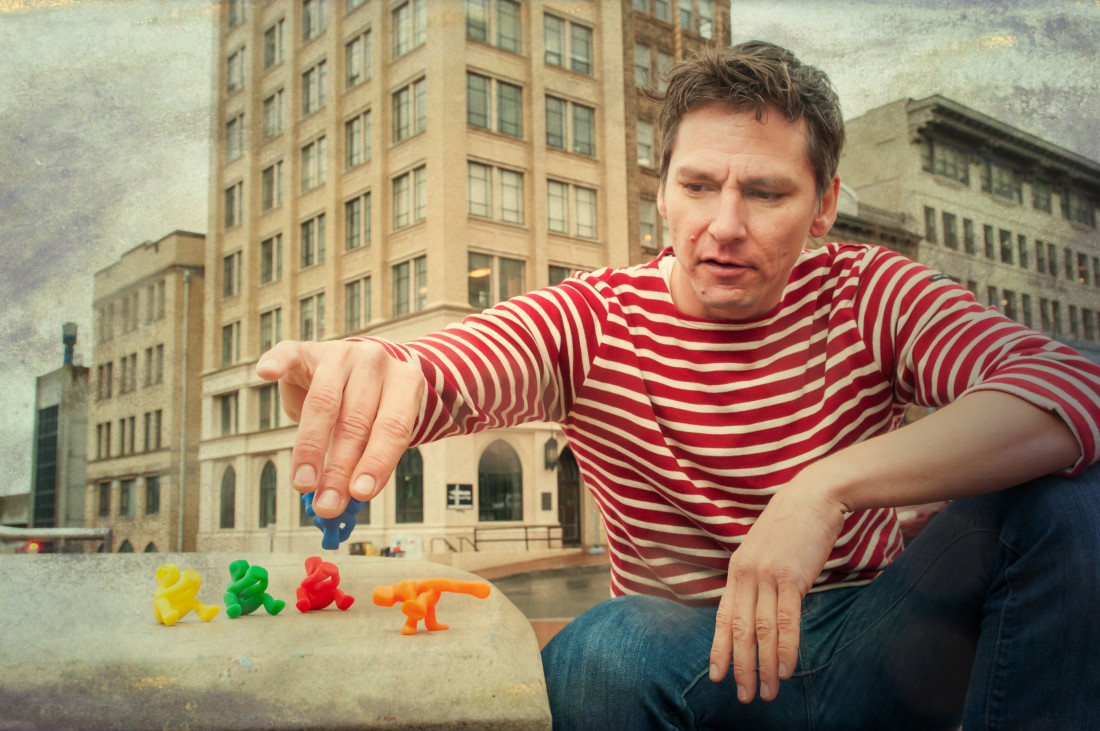When local educator, dancer and designer Joe Adams shares an action figure from his Underdog Crew Collectibles, he tells the recipient, “This is a symbol of all things good and possible.” The figures, which balance, spin and pose in break dance freezes, are not only made with positive intentions, but they represent Adams’ hope to better the world.
The artist has lofty goals for his small toys. “They’re the next generation of the green army men,” he says, “but instead of carrying weapons, they dance. They’re peace warriors.”
While the Underdog Crew Collectibles are sure to appeal to break dancers (aka b-boys and b-girls) and their fans, one doesn’t need to be proficient in windmills or the worm to appreciate the 3-D printed figures. They’re not gender-specific and they have no particular nationality, Adams points out. Playing with them is open-ended and develops fine-motor skills.
“It’s all about this vision of educational value and social mission,” he says. “I started taking them into my classes to talk about shapes and the mechanics of doing freezes.” Funded by a grant from Asheville City Schools, Adams is currently an artist-in-education at Isaac Dickson. For five weeks, all third-grade students take physical education with him. In that class, through break dance moves, they learn about angles and balance. The toys help Adams to engage the kids.
Like his Isaac Dickson students, Adams has gone back to school. In 2015, he was accepted into Accelerating Appalachia, an immersive small-business education program, where he’d learn to hone his triple-bottom-line and sustainable business plan. He had his first three prototypes made at Western Carolina University’s rapid prototyping facility and, through a GoFundMe campaign, raised some revenue to begin printing the figures through local company Spectra 3D.
The educational component of Adams’ vision comes not just from a desire to teach, but to pay forward positive experiences from his own childhood. Growing up in Roanoke, Va., he was labeled at risk. “I despised it. I hated that it was my situation,” he says. “At the same time, the help I received because of that label was crucial.”
When he heard Majora Carter speak at Burton Street a few years ago, the urban revitalization strategist made a point that refined Adams’ own thought process. “She was talking a lot about the environment, and what I realized is that climate change is the great equalizer,” Adams says. “We are all at risk.” He began to see how struggles extend beyond race and socioeconomic lines and that his work, too, can reach people of all walks of life.
“When I work with a group that’s inclusive of at-risk youths, then it’s an equal playing field,” Adams says. “The journey I’m on is not as much about being an entrepreneur as much as making an impact.”
So what, then, is the connection between a toy and an arts and education initiative? For Adams, it’s hip-hop. The dance form, he points out, is a global culture that transcends language barriers. It thrives in impoverished areas because it doesn’t cost anything to dance, yet the act provides a powerful platform for creative expression. The B in b-boy or b-girl is about the break — dancing to the breaks in the music, or reaching a breaking point. “But for me, the B is for ‘be your best,’” says Adams. “If I want to be able to do all these moves, I’ve got to be in good health. I’ve got to practice and train, and then things I didn’t think were possible become possible.”
What hip-hop taught Adams was self-control and focus. He loves the dance so much that he used to take every toy he could find and either make it spin on its head or do a freeze. Around 2007, a line of collectible figurines called Lil Homies was on the market. The toys were inspired by Latin hip-hop culture but also reinforced stereotypes, Adams says. “And they didn’t function.” Someone gave him Sculpy, a polymer clay, out of which he fashioned his own hip-hop figurine. “The first one I ever made, I took it out of the oven, let it cool and spun it on its head. It worked so well, that was my aha moment.”
Friends advised Adams to keep the idea to himself to prevent another maker from running with it, but he’s since come to the conclusion that it’s more important to him to be able to share the figures than it is to guard the concept. For now, Adams is selling his Underdog Crew Collectibles online at shapeways.com/shops/underdogcrew, and at various craft fairs. He’s also working on making connections to push his product into global awareness, though the process is also rooted in grass-roots ideals.
“Why a toy? Why not medicine, water or money?” Adams asks, rhetorically. “In my own youth, having toys was an outlet to imagine a better world. To work out the situations that were happening around me in positive play. Things shouldn’t be so hard for children.”
The Underdog Crew figurines carry the weight of those assertions on their small-but-mighty shoulders. “Having some outlet for hope is what it’s all about,” says Adams. His toy company, he adds, is “not a business, it’s a movement.”
Learn more at underdogcrew.com




Before you comment
The comments section is here to provide a platform for civil dialogue on the issues we face together as a local community. Xpress is committed to offering this platform for all voices, but when the tone of the discussion gets nasty or strays off topic, we believe many people choose not to participate. Xpress editors are determined to moderate comments to ensure a constructive interchange is maintained. All comments judged not to be in keeping with the spirit of civil discourse will be removed and repeat violators will be banned. See here for our terms of service. Thank you for being part of this effort to promote respectful discussion.